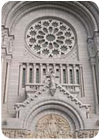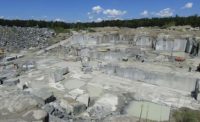

The history of this holy shrine dates back over 350 years to 1652, when three sailors traveling the St. Lawrence River shipwrecked just off the coast of Cap Tourmente, a stormy passage east of Quebec City. Stranded with no help in sight, they spent the next 24 hours on top of their capsized vessel. Sometime in the night, the three made a pact that if they were fortunate enough to survive, they would erect a chapel right on the very sight.

However, the struggle for control of the St. Lawrence Seaway between the English, French and Americans brought devastation and fire to the shores of Quebec, destroying the chapel dedicated to Saint Anne on three different occasions. In 1911, Amede Bussiere and his son Ronald, well-known granite fabricators from nearby Saint Henry, were summoned by the parish priest to begin building the exterior walls of a new basilica.
The Bussiere family, joined years later by Ronald's son Marc, ultimately obtained the bid to provide all the granite and fabrication for this enormous project in October of 1923. With the architect's plan in hand, the Bussieres set about the task of quarrying the granite and delivering it to the site to begin piece-by-piece fabrication.


“My family came to Saint Sebastian in 1911, and we still play an important role in the construction industry today,†said Marc Bussiere. “I'm proud of my grandfather, my father, my brother and everybody else who played a role in the success of this incredible project.â€

Jean-Nil Bouchard, geologist/historian at Polycor, is another resident “expert†on the basilica, and he has an intimate knowledge of the building and its history. “[The basilica] is so impressive, especially the sound,†he said. “You can speak normally from the main altar and still be heard perfectly all the way across the chapel.†To this end, representatives from New York's Carnegie Hall regularly visit the basilica to study its acoustics.
In addition to appreciating the grandeur of cathedral itself, those who are associated with it everyday enjoy the benefit of seeing the positive reactions of those seeing it for the first time. “I have seen so many [testimonials], I can't imagine one more powerful than the other,†said a priest at the basilica. “These scenes have been my every day for 30 years.â€
